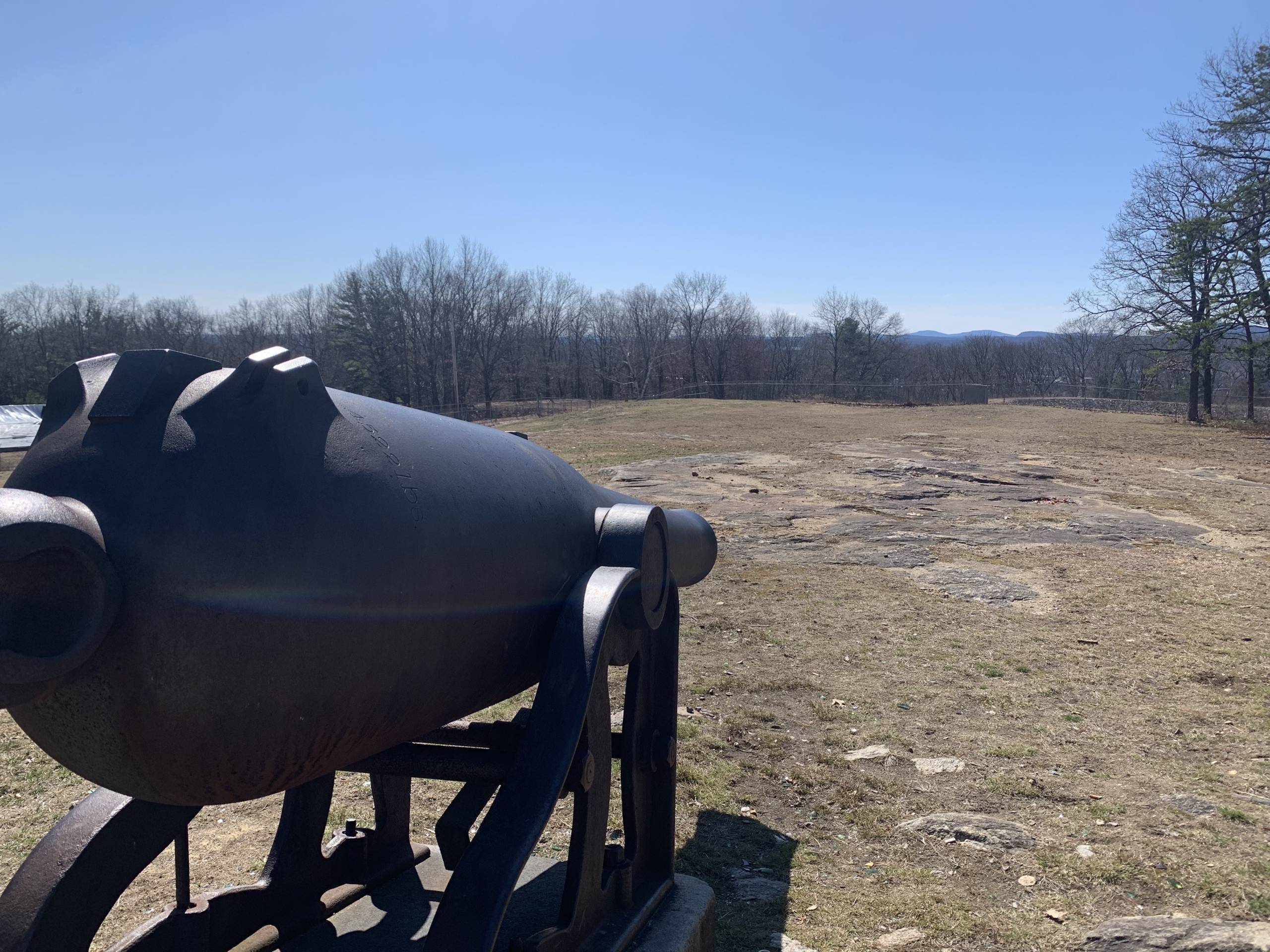MANCHESTER, NH – It’s no secret that Manchester is a historic city. From the legacy of revolutionary war hero General John Stark, to the booming industrial revolution that occurred in the millyard during the 19th century, little remnants from the Queen City’s past are scattered all around us. Three historical sites in particular all sit within a three-mile radius on the northeast city side between Derryfield Park and the VA Hospital: Weston Observatory Tower, The Town Pound Door, and Smyth Tower. While the old town pound door reminds citizens of our colonial and agrarian past, the Smyth and Weston towers pay homage to two former Manchester politicians, and share a connection regarding Manchester’s former wartime efforts.

Old Town Pound Door
Situated in Derryfield Park near Reservoir Ave and Hillside Middle School, a faded, scratched wooden door stands visible, supported only by a few stone blocks with the following engraving:
TOWN POUND
MDCCCXLI
___________
Molly Stark Chapter
D.A.R.
1916

Though the wobbly stone archway and archaic door seemingly lead to nowhere, this doorway was once the entry to the Derryfield Town Pound. Erected in 1841 in Derryfield (present-day Manchester), the town pound served as a holding pen for local farm animals that had gone astray from their owners. Town pounds were common entities during the colonial era in New England, where loose barn animals were a common problem. One person was elected to serve each year as the pound keeper. These appointed officials were coined “hog reeves” for the high number of swine that were often held within until their owners came to retrieve them. The selected hog reeve would be tasked with rounding up loose animals from town, providing them with food and water, and would subsequently charge the farmers to release the animal back into their care. While the town pound door in Derryfield Park hails back to just 1841, notable residents of the area such as John Goffe (revolutionary war soldier, and namesake for Goffstown) and Archibald Stark (father of Gen. John Stark) were notable pound keepers in years prior.
By 1916, the old town pound was in a state of disrepair. The Molly Stark Chapter of the Daughters of the American Revolution saw the misshapen hog pen as a chance to preserve history and worked to immortalize just the door surrounded by a few stone pillars. The rest of the stone pound enclosure was dismembered permanently.

Weston Observatory Tower
Standing 66 feet tall at the summit of Oak Hill, near Derryfield Park, lies the historic Weston Observatory Tower. With nearby trails for biking and walking, this preserved granite watchtower is perfect for a sunny day out, though it’s history goes mostly unknown by locals. The tower was first built in 1897 with funds granted by the late James A. Weston of Manchester. Originally open for public viewings over the city and Uncanoonuc Mountains, the tower turned to military use during WWII where air raid wardens remained vigilant on the home front. Following WWII, the tower housed police transmitters, though it eventually fell into disrepair. Upon its restoration, the tower obtained a rod-iron fence, where locals were previously offered the chance to enter the tower annually for foliage viewing by the Manchester Historic Association, before COVID-19.

But who is the man behind Weston Observatory Tower? James A. Weston, born in Manchester in 1827, went on to become a civil engineer, banker, mathematician, five-term mayor for Manchester, and two-term governor of New Hampshire. Weston began his engineering career at the age of 19, where he assisted with the development of the Concord Railroad. At the age of 22, Weston was promoted to the rank of chief engineer, and earned an honorary Master of Arts from Dartmouth College in 1871. Following his mayoral experience, Weston was elected governor in 1861, and re-elected in 1874. Though Manchester was primarily a republican city in the 1860s and 1870s, Weston notably won over the local population as a democratic candidate. Following his second gubernatorial term, Weston retired from his political life and died in 1895. Respects can be paid to his gravesite at Pine Grove Cemetery, where he is interned.

Smyth Tower
Situated in the rear of the Veterans Affairs Hospital lies the historic Smyth Tower, first commissioned by New Hampshire Governor Frederick Smyth. Similar to the previously mentioned James Weston, Smyth served as a railroad executive, banker, mayor of Manchester, and two-term governor, though with the Republican Party. In 1886, Smyth married his second wife, Emily Hamilton Cossar, in Carmichael, Lanarkshire, Scotland. Upon returning to his estate in Manchester, Smyth began planning the construction of the tower which was inspired by one he saw during his trip to Scotland. The tower stands 40 feet tall, and features an interior with a concrete slabbed basement, and three stories with wooden floors. Following Smyth’s death in 1938, the tower was donated to his widow until it went into use for radio communications for WWII. The call sign was noted to be W1LVK inside the station. The property in which Smyth’s estate was once situated became transitioned into the present-day VA Hospital, though the tower has been marked on the U.S. National Register of Historic Places with efforts made by the family. The exterior of Smyth Tower can normally be seen from the grounds at the VA, though it is currently inaccessible due to ongoing construction at the hospital. 
Sources
- https://nutfieldgenealogy.blogspot.com/2017/09/derryfield-town-pound.html
- https://en.wikipedia.org/wiki/Hog_reeve
- https://manchesterstories.com/manchester-town-pound/
- https://en.wikipedia.org/wiki/Weston_Observatory_(Manchester,_New_Hampshire)
- https://en.wikipedia.org/wiki/James_A._Weston
- https://www.manchesternh.gov/Departments/Parks-and-Recreation/Parks-Trails-and-Facilities/Parks/Weston-Tower#:~:text=The%20observatory%20was%20built%20in,Chief%20Engineer%20within%20three%20years.
- https://en.wikipedia.org/wiki/Smyth_Tower
- https://en.wikipedia.org/wiki/Frederick_Smyth_(New_Hampshire_politician)
- https://harriman.com/veterans-affairs-medical-center-2/







